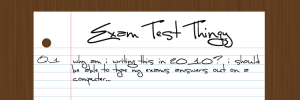The Next Steps
42 Artificial Intelligence, Homework, Exams and so forth
A favourite argument to promise artificial intelligence a bright future in education is that AI can take care of exams for us.

As of December 2022, here are some ways by which artificial intelligence can ‘help’ a teacher with exams:
- Automatic text evaluation
- Controlling student activities during the exam. This is called proctoring. Webcams and other sensors are supposed to check what is happening. During Covid, companies proposing this type of service flourished. But the use of e-proctoring is controversial, and some authors have suggested that such technologies can be intrusive, lead to racial discrimination, and more generally, do not work1,2.
- Plagiarism control. Tools are available online which will compare an essay with a large bank of essays. Even if most of the effort is not AI, there are tools that aim to find near-plagiarism, ie, situations where the essay has been partially rewritten. A typical tool is Turnitin. Many universities use it or a similar tool. In some cases the university will adopt a policy as to how it should be used and what are the students’ rights in the matter.
- Automatic setting of individualised questions. This has been done for a long time now, and can be found in popular learning management systems such as Moodle3.
Homework obeys to at least three logical tenets4:
- In some cases it is a form of summative assessment:The grades are given, depending on a combination of results; it is felt by some teachers that asking pupils to work at home, at their own rhythm, may be less stressful. Often it is the case that the teacher doesn’t have enough time to cover the curriculum unless evaluation is taken outside classroom time.
- In other cases the homework is there to add another layer to the knowledge built in classroom.
- In the third case, an exam is due to take place next week, and the pupil needs to prepare. Sometimes exercises and activities are provided; in others a memorisation effort is asked of the pupils.
Many opinions have been given regarding homework. As they vary from culture to culture, we will not express them here.

When the goal of homework is not made clear to pupils, they will not do it, if at all possible.
AI tools can expose who has been cheating in their homework.
- In maths, tools such as Photomath allow to take a picture of the equation to be solved and obtain directly a solution.
- Again in mathematics, ChatGPT and derived generative AI tools able to solve simple mathematical problems are now available.
- In language learning, automatic translation tools, such as Deepl and Google Translate, are regularly used during homework;
- In literature and social sciences, new tools are emerging. Essays generated using AI tools can fool teachers.
Our goal here is not to be exhaustive. New articles are being written on these topics every day. There is no ready-to-use solution. Our goal is to create awareness and encourage communities of practice to start thinking about this. Before examining some ideas as to how this could happen, let’s look at how cheating is causing problems in chess.
Chess
Chess is a game linked to both education and artificial intelligence5. Some schools use chess in education. Reasoning is involved in playing chess and other games, and it is suitable for all ages. There are initiatives to use the game of bridge in education too6.
Chess provided artificial intelligence with two major landmarks. In 1997 Gary Kasparov was beaten by Deep Blue7. In 2016 Alphazero beat all the best-running AI systems by a considerable margin. In the first case, the AI did not contain any machine learning and was based on human-designed rules. In the second, neural networks and reinforcement learning were essential. In 1997 the AI relied on hundreds of thousands of human-played games; in 2016, all of this human-made knowledge was removed and only the rules of the game were provided.
In 2022, chess is of interest because of the many polemics surrounding the question of cheating. During the Covid pandemic, most of the chess competitions took place online, and it was clear that cheating was taking place. In the case of chess, cheating is simple. Too simple. Just use your smartphone to find the move suggested by AI. This has led to having to solve the following question – how do we know when a player has cheated? Experts have devised methods involving comparing a player’s moves with those suggested by the AI programs. Since AI programs are now much better than humans, the conclusion is that a player who plays AI-recommended moves will be considered to be cheating. To be fair, the reasoning is more subtle than that, but this could be compared with our own reaction when a mediocre student does particularly well in an exam.
Cheating
What is true for chess also seem to apply to the classroom. Two things could explain why the player (or the pupil) uses AI software rather than doing the task on their own:
- AI software is simple to use
- AI software is considered superior to humans
The chess player is well aware that the moves suggested by AI are beyond their skills. But it is difficult to resist. As some teachers have told us: ‘even the better pupils use automatic translation. They will do the homework without it, then check and realise that the AI answer is better.
But a question remains – is this cheating? If we go by the rules of the game, it is. But what if the intended task was to move bricks from one side of the road to the other. And the rules were that you are not allowed to use a wheelbarrow. But there is a wheelbarrow available and you reckon no one is looking. Yes, you are not supposed to use the wheelbarrow, but doesn’t it make sense to make the task shorter and be more efficient?
Teacher in the loop
From the above we note that opportunities for cheating are going to be evermore present. And that – at least for now – it seems difficult to convince pupils not to use this increasingly available tool. The crucial question is, are we going to find ways to make a difference between classroom activities and homework? Can we accept that home activities will be done with the help of AI?
In this article, Arvind Narayanan analyses, with a lot of good sense, what is happening, and suggests some ways the teacher can come up with interesting homework in which the cheating phenomenon won’t feature.
1 Brown 2020; Brown L. X. Z. (2020), How automated test proctoring software discriminates against disabled students, Center for Democracy & Technology, available at https://cdt.org/insights/how-automated-test-proctoring-software-discriminates-against-disabled-students/.
2 Conijn R. et al. (2022), The fear of big brother: the potential negative side-effects of proctored exams, Journal of Computer Assisted Learning, pp. 1-14, available at https://doi.org/10.1111/jcal.12651.
3 Moodle is an open and collaborative project. Many extensions and plug-ins have been built and are shared to help teachers with grading. You can start your search here: https://edwiser.org/blog/grading-in-moodle/.
4 There are a lot of positions about homework to be read on the internet. Some in favour, some against. Furthermore, the different European countries may have different rules concerning these questions. One interesting, but US based, discussion can be found here: https://www.procon.org/headlines/homework-pros-cons-procon-org/.
5 The FIDE is the body in charge of chess worldwide. It has specialists working on the issue of chess in education: https://edu.fide.com/.
6 Nukkai is a French AI company whose AI software Nook has beaten, in March 2022, teams of world champions at Bridge. They are also working on a version of Bridge which can teach logics to children. https://nukk.ai/.
7 There are many references covering the story of Deep Blue’s victory over Gary Kasparov. IBM’s view is obviously biased but worth reading as IBM will insist on the computer winning rather than the algorithm. https://www.ibm.com/ibm/history/ibm100/us/en/icons/deepblue/.
